
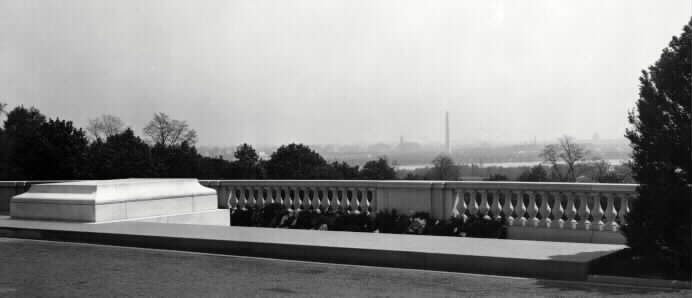

| France and England first honored their unknown war dead on 11 November 1920, and Italy and other European nations soon followed. The American commanding general in France proposed a similar project for the United States and Congressman Hamilton Fish, Jr., of New York introduced a resolution on 21 December 1920 that was approved on 4 March 1921 as Public Resolution 67 of the 66th Congress. It covered building a tomb for an unknown American soldier killed in France in Arlington National Cemetery. Because the cases of the 1,237 unidentified American dead were still being investigated, as date was ultimately set for the ceremony as Armistice Day, 1921, the third anniversary of the war's end. In response to this choice, Congress on 20 October 1921 declared 11 November 1921 a legal holiday to honor all those who participated in World War I. On 9 September 1921, the War Department directed the Quartermaster General to select an unknown soldier from those buried in France. In France, the Quartermaster Corps coordinated with French and U.S. Navy authorities to plan a selection ceremony at Chalons-sur-Marne, ninety miles east of Paris, on 23 October 1921. Four bodies were selected to exhume, and a further four otherswere picked as alternates in case any of the first four were identified. On 22 October 1921, one body was exhumed at American cemeteries—at Aisne-Maine, Meuse-Argonne, Somme, St. Mihiel. Each was examined to confirm that he had been a member of the American Expeditionary Forces, had died of wounds received in combat, and could not be identified. After mortuary preparation, the bodies were placed in identical caskets and carried by truck to Chalons-sur-Marne, where they were greeted at the city hall at 1500 hours on 23 October by French and American officials and press. Quartermaster Major Robert P. Harbold,the officer in charge of all ceremonies, had ensured the city hall was decorated with French and American flags on the outside. Inside was ornamented with palms, potted trees, and flags, and a catafalque had been constructed and set up in the main hall. The encased caskets were carried by French troops into the reception room and the caskets were removed, set on top of the cases, and draped with American flags. A French guard of honor stood watch until 2200 when six American pallbearers arrived from the American Forces in Germany. From this time on, a combined American-French guard maintained constant vigil. Each pallbearer was a decorated non-commissioned officers serving in the Army of Occupation in Germany. One of these was Sergeant Edward F. Younger, whom Major Harbold chose to select the unknown soldier. From Illinois, SGT Younger had enlisted in February 1917 and took part in many major engagements, including Chatteau-Thierry, St. Mihiel, Somme Offensive and the Meuse-Argonne Offensive. He was wounded twice and held the Distinguished Service Cross. He had re-enlisted in 1919 and was stationed with the 50th Infantry in Germany before mustering out of the Army in 1922. He died of a heart attack in Chicago, on August 6, 1942, and is buried next to his wife, in Section 18 (#1918-B) of Arlington National Cemetery.
|
In SGT Young's own words, this is what followed. "At first it was an idea that we (the six soldiers) were to be just pallbearers, but when we lined up in the little makeshift chapel, Major Harbold, the officer in charge of grave registrations, told us, 'One of you men is to be given the honor of selecting the body of the Unknown Soldier.' He had a large bouquet of pink and white roses in his arms. He finally handed the roses to me." "I was left alone in the chapel. There were four coffins, all unnamed and unmarked. The one that I placed the roses on what the one brought home and placed in the national shrine. I walked around the coffins three times, then suddenly I stopped. What caused me to stop, I don't know. It was as though something had pulled me. I placed the roses on the coffin in front of me." "I can still remember the awed feeling that I had, standing there alone." He saluted the chosen unknown American, after which the officials paid their respects, the body was placed in a special sealed casket and draped with an American flag and carried to the catafalque for public viewing. The spray of roses lay on top of the casket and floral tributes were banked around it. The caskets of the three remaining unknown Americans were taken to Romagne Cemetery, 152 miles east of Paris, for immediate re-burial. The plain pine box containing the body of the Unknown Soldier was transferred by train to Le Havre, and embarked on the cruiser USS Olympia, Admiral Dewey's old flagship, to sail to the United States to be entombed in Arlington National Cemetery. The Olympia, escorted by the American destroyer Rueben James (DD-245 —later the first American warship to be sunk in World War II ) and eight French naval vessels, left France to one 17-gun salute as she cleared harbor and another as the French ships dropped astern just outside French territory. On a rainy 9 November the Olympia sailed up the Potomac River and docked at the Washington Navy Yard, to be met with full honors and due ceremony. The casket was carried by horse-drawn caisson to the Capitol, where it lay in State until midnight on 10 November, by which time some 90,000 persons had passed the bier. The next morning, Armistice Day (Nov. 11), 1921, the casket of the Unknown Soldier was carried from the rotunda and down the east steps to the caisson, and the funeral procession left the Capitol for Arlington National Cemetery. President Harding, Vice President Coolidge, Chief Justice Taft and the other justices of the Supreme Court, and members of the cabinet, Senate, and House of Representatives led the cortege on foot to the White House, and the procession continued on to Arlington National Cemetery for the service. All holders of this highest military award had been invited to participate, and the medal of honor winners marched eight abreast.  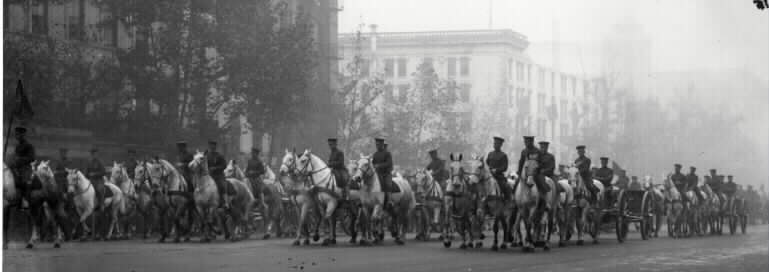 |
|||||||||||
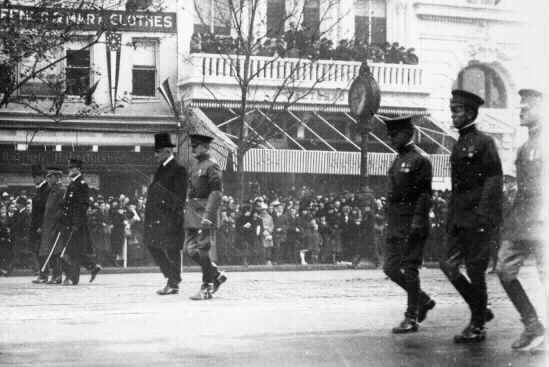 President Harding took his place in the apse, and the ceremony began. He placed the Medal of Honor and the Distinguished Service Cross upon the casket of the Unknown Soldier. A British dignitary added the Victoria Cross, followed by decorations from France, Italy, Rumania, Czechoslovakia and Poland. Then a Belgian general emotionally ripped from his tunic the Medal of Valor pinned on him by his own King and put that down where the American soldier's chest should have been. 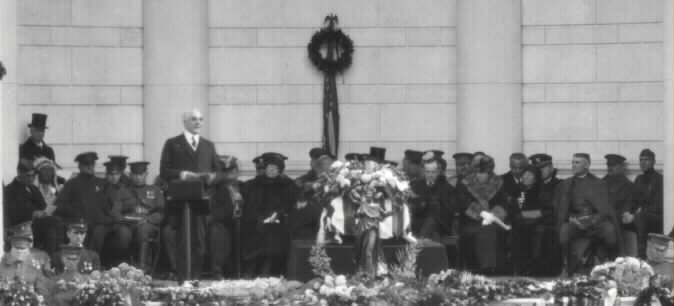 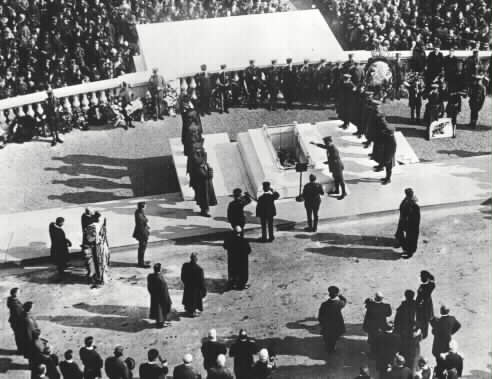 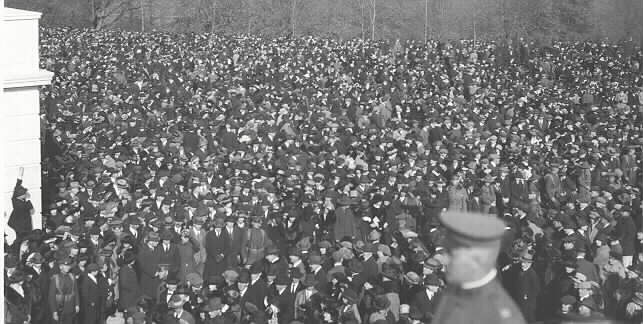 Congressman Fish, who had introduced the legislation leading to the Tomb of the Unknown Soldier laid a wreath. Among many others who then offered tribute was Chief Plenty Coups, Chief of the Crow Nation. Representing all American Indians, he laid his war bonnet and coup stick at the tomb. |
Artillery
fired three salvos as the casket was lowered into the crypt, the bottom
of which had been covered with a layer of soil from France. The bugler sounded
taps. After the last note a twenty-one guns salute was fired to the Unknown
Soldier of World War I. The tomb, completed in 1931, bears the inscription: 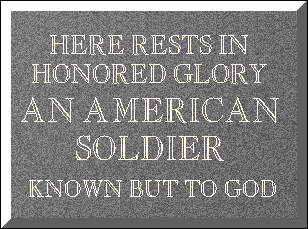
Congress later directed that an "Unknown American" from each of three wars--World War II (1939-1945), the Korean War (1950-1953), and the Vietnam War (1957-1975)--be buried beside the Tomb of the Unknown Soldier. The World War II and Korean War unknowns were buried in marble-capped crypts at the head of the tomb on Memorial Day in 1958. The unknown serviceman of the Vietnam War was buried between them during a Memorial Day ceremony in 1984. The World War II unknown was chosen from two unidentified soldiers in a ceremony aboard the cruiser Canberra off Norfolk, Virginia. The Korean War unknown was chosen from the unidentified Korean War dead buried in the National Memorial Cemetery of the Pacific at Honolulu, Hawaii. While over 2,400 Vietnam War servicemen were still listed as missing at the time, the Vietnam War unknown was the only American serviceman killed in that war whose remains could not be identified. However, DNA testing in 1998 determined that the Vietnam War unknown was Michael Blassie, an Air Force lieutenant shot down over South Vietnam in 1972. Later that year, the remains of Lieutenant Blassie were moved to a veterans cemetery near St. Louis, Missouri. An amphitheater stands near the tomb. Memorial Day services are held there each year. An honor guard from the 1st Battalion Group, 3rd Infantry, Fort Myer, Virginia, keeps a sentry on duty at all times.  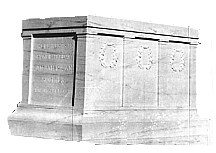 |
|||||||||||